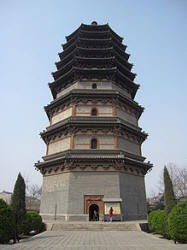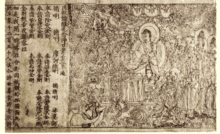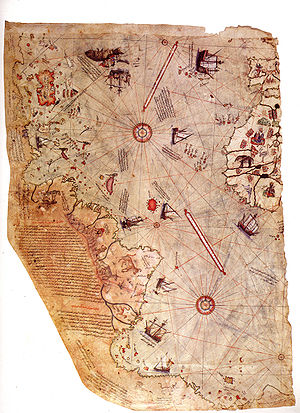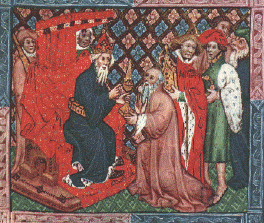
Silk Road Trade & Travel Encyclopedia
丝绸之路网站(丝路网站)
丝绸之路百科全书—游客、学生和教师的参考资源
İPEK YOLU
ve YOLLARI
ANSİKLOPEDİSİ
www.ipekyollari.net
P
A B
C
D
E
F
G
H I
J
K
L
M
N O P
Q
R
S
T
U V
W
X
Y
Z
Pack animal is a
beast of burden used by
humans as a means
of
transporting materials by attaching them so their weight bears on the
animal's back. Many species are considered traditional Silk Road pack animals,
especially camels, horses, and donkeys (while others are such as
elephants,
yaks,
goats, and
water buffalo are used to pull carts and for labor).
Pagoda
In China, pagodas were originally
built to preserve Buddhist relics, which were considered the most
sacred objects in the world. The structure of Chinese pagodas can be divided
into three parts: the top, the body (used to enshrined a statue of Buddha) and
the base (used for burying Buddhist relics). During the Han period, the use of
pagodas came to
China from India, along with other goods and
ideas, via traders on the Silk Road. Most pagodas were built to
have a religious function, most commonly
Buddhist,
and were often located in or near
temples.
More...

Lingxioa Pagoda of Hebei, built 1045
Paiza (Chinese p'ai-tse, Mongolian gerege) A
Mongol Paiza is a tablet of authority, written in the Uigher script, usually
made of wood, silver or gold, and in some cases with a depiction of a tiger or a
gyrfalcon, depending of the rank and importance of the holder. It has been
reported that travelers who possessed a paiza could travel about 25 miles a day
(however urgent messages were transported much faster).
Pakistan Karakoram Highway (Urdu:
شاہراہ قراقرم;
Chinese: 喀喇昆仑公路) is the highest paved
international road in the world. It connects
Pakistan and
China across the
Karakoram
mountain range, through the
Khunjerab Pass, at an altitude of 4,693 m/15,397 ft. (connecting
China's
Xinjiang
region with Pakistan's
Gilgit-Baltistan). It borders Pakistan's
Khyber Pukhtunkhwa province to the west,
Afghanistan's
Wakhan Corridor to the north,
China to the
northeast,
Azad
Kashmir to the south and
Jammu & Kashmir to the southeast.
Palaeontology (Paleontology) is the scientific study of life in the
geologic past, especially through the study of animal and plant fossils. Fossils
found in China since the 1990s have provided new information about the earliest
evolution of animals,
early fish, dinosaurs
and the evolution of birds and mammals.
(See Gobi Desert)
Palmyra The city of Palmyra, located in Syria, is
an ancient oasis city of the Silk Road where the
Incense
Trail, and overland subsidiaries of the Spice Route once met. Silk Road traders detoured to Palmyra on their way
to the Mediterranean coast in search of Phoenicia’s royal purple dye. Purple silk was so expensive by the time
it reached Rome that even the wealthiest could afford only a decorative colored
strip on their clothes. The city’s ancient ruins
date to the first and second centuries.
More...
Pamir Mountains (Pamirs, Congling) The Silk Route
crosses from China over the Pamir Mountains into Central and Western Asia, and
then leads towards the eastern Mediterranean Sea, near Eastern Europe. The Pamir
Mountains are a mountain range in
Central Asia formed by
the junction or knot of the
Himalayas, Tian Shan,
Karakoram,
Kunlun, and Hindu Kush
ranges. They are among the world’s highest
mountains
Mountains. More...
Paper & paper making By the 8th
century first Iranians
and then
Arabs had imported the craft of
papermaking from China, with a
paper mill
already at work in
Baghdad in
794. Papermaking is
known to have been traced back to China about 105 CE, when
Cai Lun, an
official attached to the Imperial court during the
Han
Dynasty (202 BCE - 220 CE), created a sheet of paper. Paper had been used in China for
wrapping and padding since the 2nd century BCE, and was often used as a writing
medium by the 3rd century.
More...

An
illustrated Chinese translation of the
Diamond Sutra from the Tang
Dynasty 868 CE is the oldest dated printed book in the world, found at Dunhuang.
Parthia on the Iranian plateau, was the
most active foreign trader and consumer of Chinese silk at the end of the 2nd
century B.C. Significant trade first occurred with the establishment of the
Silk road in 114 BCE, when
Hecatompylos became an important junction. In c. 105 B.C. Parthia and China exchanged embassies and
inaugurated official bilateral trade along the caravan route that lay between
them.
Pax Mongolica ("Mongolian Peace") Security and stability was provided along the Silk
Routes in the middle of the 13th century when the family of Genghis Khan
controlled Asia from the coast of China to the Black Sea (not since the days of
the Han and Roman Empires, when the Silk Road was first opened, had there been
such an opportunity for trade). This period with the Mongols in charge of safe
routes is described as Pax Mongolica. "Mongol
Peace" is a
phrase coined by Western scholars to describe the stabilizing effects of the
conquests of the
Mongol Empire on the social, cultural and economic life of the inhabitants
of the vast
Eurasian territory that the Mongols conquered in the 13th and 14th
centuries. The term is used to describe the more secure atmosphere of commerce
and communication that the
unified administration helped to create, as well as the period of relative peace that
followed the Mongol's vast conquests.
More...
It was specifically during Kublai Khan's rule (during the Yuan-Mongol
Dynasty) that marked the zenith of the period that historians call "Pax
Mongolica," a golden age of commerce and cultural exchange between East and
West.
The Mongols sought to participate in trade through direct representatives, or
through capital provided to associations of merchants (known as "ortak"). In
addition to traditional Mongol patterns of trade (including sponsorship of the
trade of others operating in or on the regions of the steppe), the Mongols
participated in local trading systems (including the so-called tribute trade of
China). It was not just official trade that stimulated profit, for their was
also private trade that was carried on -- such as the Polo's motivation for
travelling to China. The Mongols also profited by various commercial taxes
(principally called the "tamgha"), and through systems of gift-giving in
exchange for favors, including free passage.
Pax Sinica (Latin
for "Chinese Peace") is the time of
peace in
East Asia,
maintained by Chinese hegemony,
usually the period of rule by the
Han
Dynasty,
Tang
Dynasty, early
Song
Dynasty,
Yuan
Dynasty,
Ming
Dynasty and early
Qing
Dynasty. These periods were characterized by the dominance of
Chinese civilization, as a result of its
political,
economic,
military and
cultural power.
Pegolotti
Francesco Balducci Pegolotti (c. 1340) A Florentine merchant, Pegolotti was active in
the Eastern Mediterranean in the second quarter of the fourteenth century, at
which time he acquired first- and second-hand information on the Asian trade.
While he himself never travelled further east, his account is of particular
interest for its description of the relative security of trade routes through
the territories of the Mongol Empire and the great variety of products available
in commercial centers such as Constantinople by about 1340. His merchant
handbook survived in a copy made in 1471.
Paul Pelliot (1878–1945) was a French
sinologist
and explorer
of Central Asia. See IDP
More...
Pera Palace As
Istanbul became more accessible due to the developments of 19th century
transportation, the capital to three ancient empires began to reveal its
"mysterious" identity to more Westerners. When the famous
Orient Express train
selected Istanbul as its
last stop in the East, Istanbul began to attract the more seasoned travelers of
Europe. The Pera Palace
Hotel was established in 1892 to meet the needs of European Orient
Express passengers. Some of the hotel's renowned guests (which also include Turkey's founder
and first president Mustafa Kemal Ataturk), include famous authors such as Pierre Loti, Ernst Hemingway, and Agatha Cristie, in addition to actors and actresses such as Greta Garbo, and foreign
dignitaries such as Queen Elizabeth I. The hotel is also known to have hosted
many spies as well as
statesmen. Kim Philby, the British-Soviet double agent, was nearly unmasked in
Istanbul, and the agent codenamed Cicero, valet to the British ambassador in
Ankara, visited as he sold secret documents to German agents in World War II (the
Pera Palace became a target in 1941 as the
world drifted toward war when a bomb
exploded at the entrance shortly after the arrival of a British
diplomatic party from Bulgaria, which had sided with the Nazis.
Several people died). Mata Hari, accused of spying and executed in France in
1917, also stayed at the Pera Palace Hotel. The room in which Mustafa Kemal Ataturk
stayed is on permanent display, as are items that comprise the hotel's museum
sections.
More...

Peranakan
The descendents of Chinese merchants who
established prominent communities in the Malacca Straits region of Malaysia, and
in Singapore (a.k.a. Baba-Nyonya, Nonya, or Babas).
Peshawar A
frontier city of Pakistan, located in South-Central Asia, where traders and travelers would
often stop. The city is situated near the eastern end of the
Khyber
Pass and sits mainly on the
Iranian plateau along with the rest of the Khyber-Pakhtunkhwa. Peshawar is
literally a frontier city of South-Central Asia and was historically part of the
Silk Road.
Petra
is an ancient city in Jordan,
established sometime around the 6th century BC as the capital city of the
Nabataeans.
It was located at a strategic point where the Incense Route from Arabia
to Damascus was crossed by the overland route from India to Egypt. The
rock-carved
rose-red city of
Petra also became a junction for the trade of
spices and other goods that travelled
along the trade routes that linked China, India and southern Arabia with Egypt,
Syria, Greece and Rome. Petra is included in UNESCO's
list of World Heritage Sites.
More...
Phoenicia centered in modern-day Lebanon and the coast of Syria, was an ancient civilization. Phoenician
civilization was an enterprising
maritime trading culture that spread across the
Mediterranean during the period 1550 BC to 300 BC. The Phoenicians often
traded by means of a galley, a
man-powered sailing vessel. (See Carthage)
More...
Pirate (corsair) Piracy must have existed for as long as the oceans
were plied for commerce, and grew over the centuries as the maritime silk, spice
and incense routes prospered.
More...
Pires
Tome Pires was a Portuguese apothecary and government scribe who led an
expedition from Portugal. He departed with a fleet of 4 ships, carrying
diplomatic letters, royal gifts, and goods to trade in China (c. 1511-1521).
Piri Reis was a 16th century Ottoman-Turkish admiral, geographer and cartographer.
One of his famous maps is a pre-modern world map dated 1513, which depicts the
Western Hemisphere -- the first surviving map that shows the Americas, including
North America, South America, Greenland, Antarctica, as well as the western
coast of Africa. The map is now preserved in the Topkapi Museum in Istanbul. He
has been credited for depicting parts of the western coasts of Europe and North
Africa with reasonable accuracy. Ottoman Admiral Piri Reis was born on the
Gallipoli Peninsula c.1465, and is an important figure of Turkish naval history.
In addition to creating maps of the Gallipoli Peninsula and the Dardanelles, in
1521 he also wrote a mariner's guide to the coasts and islands of the
Mediterranean ("Kitab-ı
Bahriye" translated at the "Book of the Mariner," or "The Naval Handbook"). As he dated his
famous "Map of the Americas," he added this inscription from Gallipoli: "The
author of this is the humble Piri ibn Haji Muhammad, known as the nephew of
Kemal Reis, in the town of Gallipoli in the Holy Month of Muharram of the year
919 [A.D. 1513]." Türkçe

The left fragment of the Piri Reis map shows Central and South
American coasts. In the map's legend, Admiral Piri Reis notes that the map was
based on about twenty charts and mappae
mundi, including eight Ptolemaic
maps constructed during the era of Alexander
the Great, an Arabic
map of India,
four newly drawn Portuguese
maps from Sindh, Pakistan, and a map by Christopher
Columbus of the western
lands.
More...
Plague Many diseases, including the bubonic plague (the
so-called 'Black Death') also traveled along the Silk Routes.
Polo
Marco Polo was the most famous of the Silk Road travelers (1254-1324), a trader and explorer.
His 13th century account of his travels had a profound influence on medieval
Europe's view of the wider world.
Marco Polo was a
merchant from the
Venetian Republic who introduced Europeans to Central Asia and
China. He learned about trading whilst his father and uncle,
Niccolò and Maffeo, travelled through Asia to the court of the great
Mongol leader
Kublai Khan. In 1269, they returned to Venice. The three of them embarked on an epic journey to Asia,
returning after 24 years to find Venice at war with
Genoa. Marco was imprisoned, and dictated his account to a
writer who was also imprisoned by the Genoese. He was released in 1299. He died in 1324, and was
buried in
San Lorenzo.
Marco Polo's autobiography, called 'The Travels of Marco
Polo' or "Il Milione," provided inspiration for many other explorers
including Christopher Columbus.
Il Milione was translated, embellished, copied
by hand, and adapted, however there is no authoritative version. It documents his
father's journey to meet the Kublai Khan, who asked them to become
ambassadors, and communicate with the
pope. This
led to Marco's quest, through
Acre, into China and to the
Mongol court. Marco wrote of his extensive travels throughout Asia
on behalf of the Khan, and their eventual return after 15,000 miles
(24,140 km) and 24 years of adventures.
By his own account, Marco worked for Qubilai Khan. He traveled
overland through Persia across the Pamirs and south of the Taklamakan. His return was by sea from China around
South Asia to Hormuz, from where he
went overland to the Mediterranean. Although some of the descriptions not based on direct observation,
many of his observations are
precise and verifiable.. His main
associations seem to have been with the Mongol rulers of China and with
the Muslim merchant community.
Marco Polo's journey and book
became well-known in Renaissance Europe, serving as a stimulus for
further discovery and travel. Today, his impact upon Western knowledge
of the East, as well as on the Western imagination, can still be seen.
More...

Marco
Polo at court of Kublai Khan
Polo
Niccolò and Maffeo Polo The merchant father and uncle of Marco Polo
who traveled from the Crimea through the other territories of the Golden Horde
to Bukhara and ultimately to the court of Qubilai Khan in North China. Qubilai
sent them back to Europe on a mission to the Pope via the overland route; they
arrived in Venice in 1269. When they departed again for China in 1271 via the
Levant, Anatolia and Persia, they were accompanied by young Marco Polo. Our
knowledge of their travel is from Marco's book.
More...
Porcelain Export Chinese export porcelain includes a wide range of porcelain
that was made and decorated in China
exclusively for export. More...
Porcelain Route In the 15th century, the Portuguese under Prince Henry
the Navigator discovered the sea route, which became known in later centuries as
“The Porcelain Route.”
Portugal The
Republic of Venice had become a formidable power, and a
key player in the Eastern spice trade. Other powers, in an attempt to break the
Venetian hold on spice trade, began to build up maritime capability. One of the
major consequences of the spice trade was the discovery of the American
continent by European explorers. Until the mid 15th century, trade with the east
was achieved through the Silk Road, with the Byzantine Empire and the Italian
city-states of Venice and Genoa acting as a middle man. In 1453, when the
Ottomans took Constantinople, the Byzantine Empire collapsed. The Ottoman Empire
now controlled the sole spice trade route that existed, and was in a favorable
position to charge hefty taxes on merchandise bound for the west. The Western
Europeans, not wanting to be dependent on an expansionist, non-Christian power
for the lucrative commerce with the east, set about to find an alternate sea
route around Africa.
The first country to attempt to circumnavigate Africa was Portugal, which
since the early 15th century had already begun to explore northern Africa under
Henry the Navigator.
Emboldened by these early successes and eyeing a lucrative monopoly on a
possible sea route to the Indies
the Portuguese first crossed the
Cape of Good Hope
in 1488 on an expedition led by
Bartolomeu Dias. Just
nine years later in 1497 on the orders of
Manuel I of Portugal,
four vessels under the command of navigator
Vasco da Gama rounded
the Cape of Good Hope, continuing to the eastern coast of Africa to
Malindi to sail across the
Indian Ocean to
Calicut, a south Indian city in the state of Kerala. The wealth of the
Indies was now open for the Europeans to explore. The
Portuguese Empire
was the earliest European seaborne empire to grow from the spice trade
More...
Printing Wood block printing is a
technique for printing text, images or patterns that originated in
China. The
earliest surviving examples from China date to before 220 CE.
More...
Provinces (China) The Silk Routes pass through 5 provinces of modern
day China: Xinjiang, Qinghai, Ningxia, Gansu, and Shaanxi.
Purgstall
Joseph von Hammer-Purgstall (1774 – 1856) was an
Austrian
Orientalist. Entering the diplomatic service in 1796, he was appointed in
1799 to a position in the Austrian embassy in Istanbul.
Silk Routes.net |
Ipek Yollari.net





